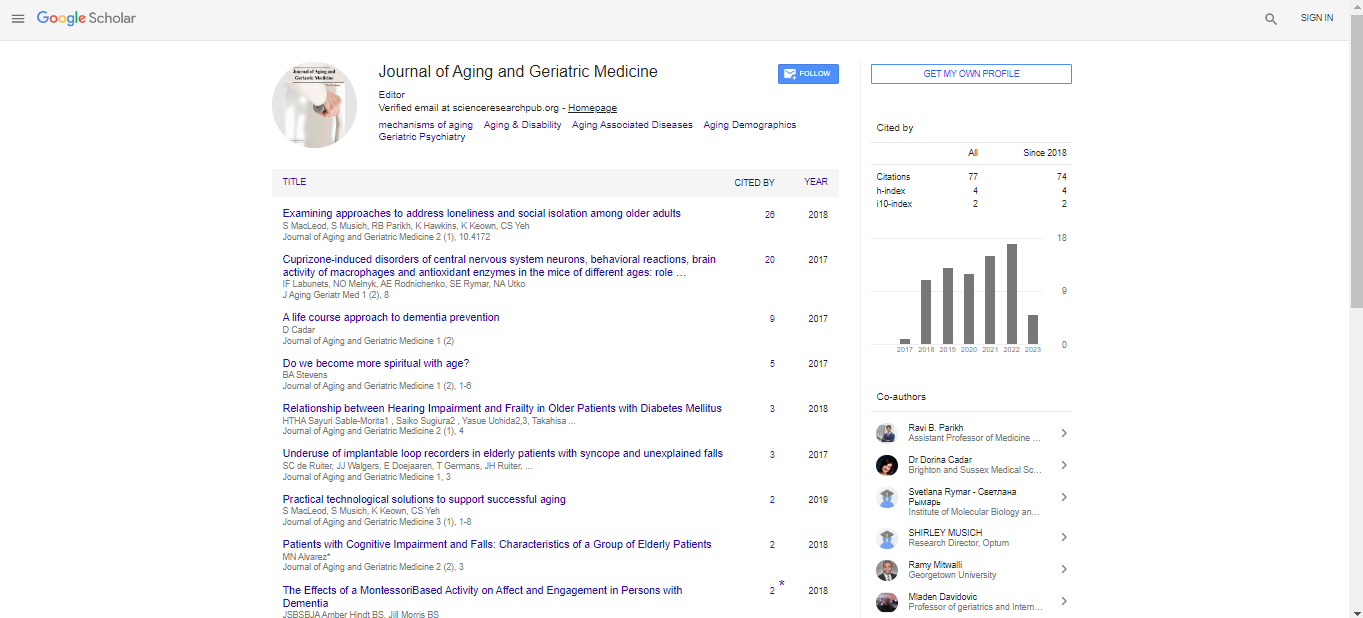Editorial, J Aging Geriatr Med Vol: 8 Issue: 1
Osteoporosis: The Silent Bone Disease
Simony Gyrus*
Department of Health Sciences, WrocÅ?aw University of Science and Technology, Poland
- *Corresponding Author:
- Simony Gyrus
Department of Health Sciences, WrocÅ?aw University of Science and Technology, Poland
E-mail: gyrus528@gmail.com
Received: 01-Jan-2025, Manuscript No. agm-25-169743; Editor assigned: 4-Jan-2025, Pre-QC No. agm-25-169743 (PQ); Reviewed: 18-Jan-2025, QC No. agm-25-169743; Revised: 25-Jan-2025, Manuscript No. agm-25-169743 (R); Published: 30-Jan-2025, DOI: 10.4172/2576-3946.1000177
Citation: Simony G (2025) Osteoporosis: The Silent Bone Disease. J Aging Geriatr Med 8:177
Introduction
Osteoporosis is a common yet often overlooked condition that weakens bones, making them fragile and more likely to break. Often referred to as the “silent disease,” it progresses without symptoms until a fracture occurs. This chronic condition affects millions worldwide, particularly older adults, and has significant health, social, and economic consequences.
Osteoporosis is a progressive bone disease characterized by decreased bone mass and deterioration of bone tissue, leading to increased bone fragility and a higher risk of fractures. Often called the “silent disease,” it typically develops without noticeable symptoms until a fracture occurs—commonly in the hip, spine, or wrist. These fractures can have serious health consequences, particularly in older adults, often resulting in chronic pain, disability, or even death in severe cases [1], [2].
Bone is a living tissue that continuously undergoes a process of breakdown and renewal. In youth, bone formation exceeds bone loss, allowing individuals to build strong skeletal structures. However, as people age—especially postmenopausal women due to decreased estrogen levels—this balance shifts. Bone loss begins to outpace bone formation, making bones more porous and weak. While osteoporosis can affect anyone, women over 50 and men over 70 are at the highest risk [3], [4].
Several risk factors contribute to the development of osteoporosis, including genetics, hormonal changes, poor nutrition (particularly calcium and vitamin D deficiency), sedentary lifestyle, smoking, and excessive alcohol consumption. Certain medications and medical conditions, such as rheumatoid arthritis or chronic steroid use, also increase risk.
Despite its prevalence, osteoporosis is preventable and manageable. Early detection through bone mineral density (BMD) testing, especially using a DEXA scan, can identify individuals at risk before fractures occur. Preventive strategies—such as maintaining a healthy diet, regular weight-bearing exercise, and avoiding harmful habits like smoking—are key to preserving bone health [5].
Understanding osteoporosis is essential for reducing its impact on individuals and healthcare systems alike. With proper awareness, lifestyle changes, and medical intervention, those at risk can maintain stronger bones and a higher quality of life well into older age.
Discussion
Osteoporosis is a common metabolic bone disease characterized by decreased bone density and deterioration of bone microarchitecture, leading to increased bone fragility and risk of fractures. It predominantly affects older adults, especially postmenopausal women, due to hormonal changes that accelerate bone loss. However, men and younger individuals with certain risk factors are also susceptible.
The condition often remains silent until a fracture occurs, which commonly involves the hip, spine, or wrist. These fractures can result in significant morbidity, reduced mobility, loss of independence, and increased mortality, particularly in elderly populations. Vertebral fractures, in particular, may be asymptomatic but cause height loss, chronic pain, and spinal deformities.
Osteoporosis results from an imbalance between bone resorption and bone formation. Risk factors include aging, estrogen deficiency, low calcium and vitamin D intake, sedentary lifestyle, smoking, excessive alcohol consumption, certain medications (e.g., corticosteroids), and underlying medical conditions like rheumatoid arthritis.
Diagnosis is primarily based on measuring bone mineral density (BMD) using dual-energy X-ray absorptiometry (DXA). The World Health Organization classifies osteoporosis when BMD is 2.5 standard deviations below the young adult mean. Early diagnosis is essential for initiating treatment and preventing fractures.
Management includes lifestyle modifications such as adequate calcium and vitamin D intake, regular weight-bearing exercise, smoking cessation, and limiting alcohol. Pharmacological therapies, including bisphosphonates, selective estrogen receptor modulators, and monoclonal antibodies like denosumab, help reduce fracture risk by inhibiting bone resorption or stimulating bone formation.
In summary, osteoporosis is a significant public health concern due to its prevalence and impact on quality of life. Preventive measures, early detection, and effective treatment strategies are crucial to reducing fracture incidence and improving outcomes for those affected.
Conclusion
Osteoporosis is a major public health concern, particularly in aging populations. Though it often progresses silently, its effects can be devastating. Fortunately, with early detection, lifestyle modifications, and appropriate medical care, individuals can reduce their risk of fractures and maintain independence as they age. Promoting awareness, preventive strategies, and access to treatment is essential in reducing the global burden of this disease.
References
- Boulet SL, Alexander GR, Salihu HM, Pass M (2003) Macrosomic births in the United States: determinants, outcomes, and proposed grades of risk. Am J Obstet Gynecol 188: 1372-1378.
- Zhang X, Decker A, Platt RW, Kramer MS (2008) How big is too big? The perinatal consequences of fetal macrosomia. Am J Obstet Gynecol 198: 517.
- Colletti JE, Kothari, S, Kothori S, Jackson DM, Kilgore KP, et al. (2007) "An emergency medicine approach to neonatal hyperbilirubinemia". Emerg Med Clin North Am 25: 1117-35.
- Watchko JF (2006) "Hyperbilirubinemia and bilirubin toxicity in the late preterm infant". Clin Perinatol 33: 839-582.
- Shah Z, Chawla A, Patkar D, Pungaonkar S (2003) "MRI in kernicterus". Australas Radiol 47: 55-57.
Indexed at, Google Scholar, Crossref
Indexed at, Google Scholar, Crossref
Indexed at, Google Scholar, Crossref
Indexed at, Google Scholar, Crossref
 Spanish
Spanish  Chinese
Chinese  Russian
Russian  German
German  French
French  Japanese
Japanese  Portuguese
Portuguese  Hindi
Hindi 